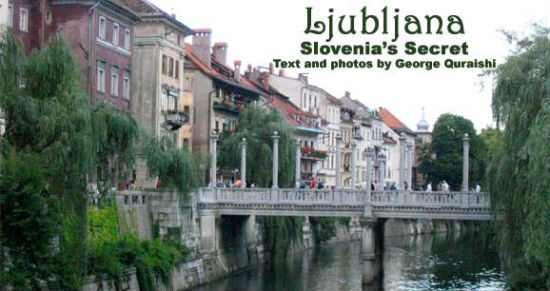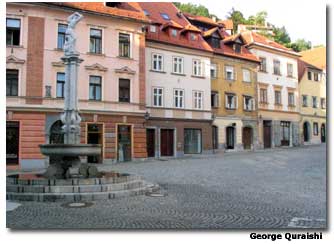

Slovenia, with its toehold of coastline, sits quietly wedged like a middle child between the two giants of the Adriatic: Italy, the older brother, his ancient arteries clogged with tourists, and Croatia, darling little sister, stretching her long legs down the coast all the way to Dubrovnik, the coolest place to get a tan since the Iron Curtain stopped blocking the sun.
But it is Ljubljana, Slovenia’s capitol, that commands the central plain dividing the coast and the Alps. This city of 270,000 is right in the middle of Slovenia, and therefore a convenient train ride from so many of Europe’s most visited places: northern Italy, Vienna, Munich, Budapest and Split, in Croatia. Ljubljana is situated geographically and, more importantly, temperamentally, as the perfect pit stop.
The best part about Ljubljana is its old town, centering on the Ljubljanica River and fanning out two streets in each direction. The river is small. You couldn’t spit to the other side but you could toss a baseball with your bad arm. The river’s sides are reinforced, so it flows through town as though in a steep, giant gutter, except the high walls are laden with ivy and terraces with flowers halfway down. Above, from street level, weeping willows lean gracefully over the embankment.
Five bridges span the river in this part of town, three of them pedestrian. The banishment of automobiles is what gives Ljubljana such a peaceful feel. Those willows just wouldn’t look the same amid car horns and exhaust fumes. But they shine when serenaded — along with the humans eating their dinner — by classical guitar or accordion. Chatter emanates from street-side cafés, bars and restaurants. These are the sounds you hear on a stroll up and down the river at night.
If you’re looking for a mouthful, Ljubljana is happy to oblige. Italian cooking dominates and most Slovenian restaurants here feature menus heavily derived from Italian kitchens. Pizzeria Ljubljanski Dvor, a riverside place, has a menu with what seems like every known combination of toppings one can imagine on a pizza — anything with their spicy salami is good.
Restaurant Julija, one street back from the river, serves pasta dishes on its candlelit street-side tables. The spaghetti with a creamy prosciutto and mushroom sauce is excellent.
For dessert, a good place is Slascicarna, a coffee and pastry shop down the street from Restaurant Julija. Try a slice ofblejsna rezina. “It’s typical for Slovenia,” the waitress assures. It is flaky on top and bottom with powdered sugar and a bulging, creamy, cannoli-like middle. Numerous ice cream carts stand at attention along the river promenade with the usual flavors, plus whisky and ferrero rocher chocolate.
The town doesn’t get many tourists; it doesn’t have many tourist sites. There is an excellent fruit and flower market, but that is hardly something to plan a trip around. The city’s castle, dating back to the 11th century and looming directly over the old town on a high hill, is well preserved and worth a visit, if only for the view from the bell tower. The National History Museum is well cared for, but it really only has an exhibit of wacky furniture and a humdrum natural history section.
Ljubljana, erected by the Romans under the name of Emona in 15 AD, was officially documented under its German name Laibach in 1144. It has been hard hit by several earthquakes. After a quake in 1511, the city was rebuilt in Renaissance-style only to be severely damaged again by an earthquake in 1895. This time it was reconstructed in Neo-Classicist and Art Nouveau styles. This is why Ljubljana’s architecture today is a mix of different styles. Large areas built between the two World Wars display the work of local architect Jože Plečnik (1872-1957). A search for the home of the city’s most famous resident, although appearing on maps, yielded nothing.
But the lack of tourists is decidedly in Ljubljana’s favor, as far as making it an untouched destination. Prices are low and the city resists the urge to reference itself on T-shirts, magnets and coffee mugs, or block the gorgeous views while trying to sell them.

And the views are gorgeous. Besides the baroque City Hall built in 1717, none of the old town’s buildings are a standout, but together the old façades are something to marvel at. They are yellow and purple and brown and have the air of measured decay. A little age has added greatly to their beauty. The soft lights and beautiful music carrying across both sides of the river, and the sounds of people enjoying themselves on a jaunt through it all, give the place a dignity that is very alluring.
Young people come to the old town to meet friends at the cafés. They ride their bicycles up and down the riverbank. Here, bikes and inline skates are the fastest moving “vehicles.” But wide bike lanes make this means of transportation possible throughout the city, too.
An older set fills the tables at the many riverside restaurants. They seem elegant, both the diners and the restaurants. Yet it is not clear if the people make their surroundings seem this way, or the other way around. They must be the patrons of all the high-end shops in the vicinity: Max Mara, Lacoste and a host of other expensive designer boutiques.
One night at dusk a street stage was set up for poetry reading with bongo accompaniment. On a different day, three Americans played oldies on Cobbler’s Bridge — the prettiest of all five bridges, with tall pillars on both sides.
When it is time to get back on the fast track, to hop a train to Venice or Munich or Budapest, the station is only an eight-minute walk from the old town, a safe journey (nowhere in Ljubljana did I feel threatened). But watch out for the beggar at the station. He’s young, and he goes from person to person, alms cup extended — on his inline skates.
If You Go
Slovenian Tourist Board
www.slovenia-tourism.si
Ljubljana Tourist Information
Ljubljana City Hall
- Samaná: The Dominican Republic’s Lush Peninsula Where Silence is Golden and So Is the Sand - July 15, 2025
- Washington D.C.’s Hillwood Estate: A Touch of Europe in America’s Capitol - July 15, 2025
- When Is the Best Time to Visit Venice? The Ultimate Month-by-Month Guide to Crowds, Weather & Events - July 15, 2025
